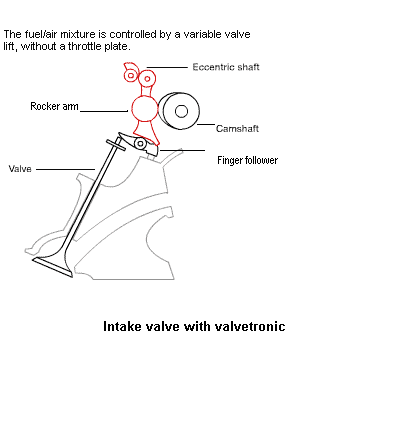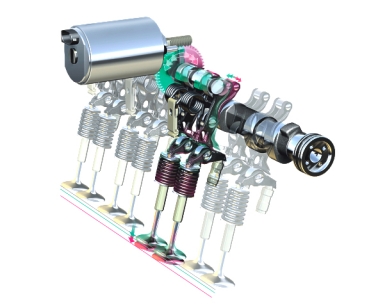





Published on Feb 14, 2025
The Valvetronic engine is the world's first engine without a throttle butterfly. Valvetronic allows the engine to run without a throttle butterfly, the cylinder charge being determined under part load as a function of the valve-opening period. The intake and outlet camshafts are driven by variable cam adjustment, BMW's Vanos technology.
A further advantage of this concept is that it allows worldwide use of the proven three-way catalyst for emissions management, thus meeting even the strictest emissions standards in the US.
Innovative technology was essential in order to reach the demanding objectives and functional requirements desired. However, at the same time, this concept demanded the utmost of the electronic control and management systems in the engine.
A comparison with the human being clearly explains how Valvetronic works: Whenever we are required to make a great effort, we human beings breathe in a deep and long process of ventilation. Whenever we need less air, we do not throttle the supply of air by, say, closing our nose or our mouth, but simply breathe in a shorter, flatter process of ventilation. In a conventional combustion engine the throttle butterfly is basically comparable to a human being keeping his nose or mouth at least partially closed. With its large valve lift (= deep, long ventilation) and short valve lift (= flat, short process of ventilation), Valvetronic, on the other hand, is able to breathe in the same way as nature - always in line with current requirements, without any kind of throttling effect and therefore with maximum efficiency.
Accordingly, the Valvetronic engine no longer requires a throttle butterfly, which has quite literally restricted the free ventilation of the internal combustion engine ever since its invention. Now Valvetronic replaces this conventional function by infinitely variable intake valve lift, offering a quantum leap in technology quite comparable to the changeover from the carburetor to fuel injection.
Its most important feature is that it is able to save at least 10 per cent fuel throughout the entire operating range relevant to the customer, with a corresponding reduction in exhaust emissions, regardless of fuel quality. And a further important point is that the efficient operation of Valvetronic does not require any unusual types and grades of oil possibly difficult to obtain.
As a result of these particular features the 85 kW/115bhp BMW 316ti compact with its top speed of 210 km/h or 125 mph consumes a mere 6.9 liters of premium fuel on 100 kilometers in the European test cycle, equivalent to 40.9 mpg Imp. This is a significant 0.7 liters less than the former 77 kW/105 bhp compact and well over a liter less than all competitors in this class.
The Valvetronic system is based consistently on BMW's proven double-VANOS (VANOS = variable adjustment of the camshafts), with infinite camshaft adjustment to meet specific requirements. The additional, variable valve lift adjusts the effective cam action and, accordingly, the opening cross-section of the valves
WORKING OF VALVETRONIC ENGINE
Working Of Ordinary Engine
In engines without valvetronic technology fuel injection systems monitor the volume of air passing through the throttle butterfly and determine the corresponding amount of fuel required by the engine. The larger the throttle butterfly opening, the more air enters the combustion chamber.
At light throttle, the throttle butterfly partially or even nearly closes. The pistons are still running, taking air from the partially closed intake manifold. The intake manifold between the throttle and the combustion chamber has a partial vacuum, resisting the sucking and pumping action of the pistons, wasting energy. Automotive engineers refer to this phenomenon as "pumping loss". The slower the engine runs, the more the throttle butterfly closes, and the more energy is lost.
Compared with conventional twin-cam engines with finger followers, Valvetronic employs an additional eccentric shaft, an electric motor and several intermediate rocker arms, which in turn activates the opening and closing of valves. If the rocker arms push deeper, the intake valves will have a higher lift, and vice-versa. Thus, Valvetronic has the ability to get deep, long ventilation (large valve lift) and flat, short ventilation (short valve lift), depending on the demands placed on the engine

Cylinder heads with Valvetronic use an extra set of rocker arms, called intermediate arms (lift scaler), positioned between the valve stem and the camshaft. These intermediate arms are able to pivot on a central point, by means of an extra, electronicly actuated camshaft. This movement alone, without any movement of the intake camshaft, can open or close the intake valves.
The Valvetronic system is based on BMW's established double VANOS system, which steplessly varies the timing of both the inlet and exhaust cams. However, the Valvetronic system adds variable valve lift to the inlet cam, achieved by the use of a lever positioned between the camshaft and the inlet valves. Valvetronic varies the timing and the lift of the intake valves. The Valvetronic system has a conventional intake cam, but it also uses a secondary eccentric shaft with a series of levers and roller followers, activated by a stepper motor.
Based on signals formerly taken mechanically from the accelerator pedal, the stepper motor changes the phase of the eccentric cam, modifying the action of the intake valves. An additional eccentric shaft alters the lever's distance from the camshaft, with the eccentric's position determined by a worm drive from an electric motor. The position of the lever converts the cam action into a smaller or larger valve lift, as requested by the engine management system. Intake vale lift can be altered from a minimum of 0.25mm to a maximum of 9.7mm, with the electric motor adjusting the eccentric shaft in 0.3 seconds.

Because the intake valves now have the ability to move from fully closed to fully open positions, and everywhere in between, the primary means of engine load control is transferred from the throttle plate to the intake valve train. By eliminating the throttle plate's "bottleneck" in the intake track, pumping losses are reduced, fuel economy and responsiveness are improved.
• Valve lift is variable between 0 and 9.7 mm.
• Adjustment of the worm gear from one extreme to the other takes 300 milliseconds.
• Combined with double-vanos valve timing technology, the camshaft angle relative to the crankshaft can be adjusted by up to 60°.
• The intermediate arm is finished to a tolerance of 0.008 mm.
The cams controlling the eccentric shaft are machined to tolerances of a few hundredths of a millimeter.
Digital Motor Electronics (DME) is a microprocessor-based system that controls the ignition, the fuel injection, the oxygen sensor and numerous ancillary functions. DME provides raw data to an on-board computer that uses an alphanumeric display to provide you with information such as the average fuel consumption, the distance you can still cover with fuel in the tank, an average speed, outside temperature and more.
In the industry, DME is often referred to as the Engine Control Unit (ECU), under the heading of Electronic Engine Management Systems. BMW also uses the term DDE (Digital Diesel Electronics) for diesel engine models instead of DME.
DME operates by continually monitoring such factors as engine temperature, speed, intake airflow, exhaust gas composition, and even the altitude. DME then literally fine-tunes the engine hundreds of times a second to provide maximum performance and efficiency. DME has a fail-safe program in the event of certain electrical faults. Current DME versions also have on-board diagnostics (OBD).
The three main tasks DME has to perform are (1) injecting the right amount of fuel and (2) providing a spark at the correct time. (3) providing variable valve timing. In order to do this, the system needs to know things about the engine's current state. DME can track dozens of different sensors, but every system needs to know three basic things:
1. how much air is coming in
2. the position of the crankshaft, and
3. how fast the engine is running.
Using the information about how much air is flowing through the engine and how fast it's turning, DME uses a fuel map to determine how long each injector should stay open each cycle to inject the right amount of fuel. During part-throttle operation, the injector pulse-width is also modified by the readings from the oxygen sensor, a device that sits in the exhaust collector and determines how much oxygen is left over in the exhaust. Each cylinder is constantly adjusted to maximum operating efficiency under virtually all conditions.
| Are you interested in this topic.Then mail to us immediately to get the full report.
email :- contactv2@gmail.com |